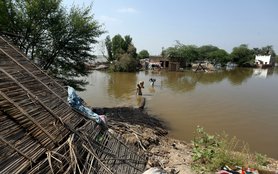[ PART OF A SERIES ON OUR CHANGING CLIMATE ] | Powerful winds, widespread flooding, and tornadoes: Ida showed us what’s on the menu for the future if we don’t act fast.
Hurricane Ida was an historic storm exacerbated by the climate crisis. Its impacts were devastating, stretching from the Gulf Coast to the East Coast, highlighting some of our deepest vulnerabilities as a society. The harsh reality is that climate disasters like Ida will keep happening, and the longer we wait to take urgent and ambitious action, the worse these events and their impacts will be. (Check out a firsthand account of the storm in Louisiana.)
A recent report from the Intergovernmental Panel on Climate Change (IPCC) found that not only are hurricanes likely to increase in strength and frequency as a result of global warming—but our window of opportunity to stave off even worse impacts of this crisis is quickly closing.
The science behind Ida
On the night of August 28th, Hurricane Ida was a strong Category 2 storm churning through the Gulf of Mexico with maximum sustained winds of 105 m.p.h. However, as the storm hit favorable atmospheric conditions and warm ocean waters, it underwent a process called “rapid intensification,” and exploded into a monster Category 4 storm in just a matter of hours, with maximum sustained winds of 150 m.p.h.
Although no hurricane is caused solely by global warming, storms like these are fueled by ocean waters that are warming as a result of climate change. In fact, more than 90% of warming caused by increasing greenhouse gas emissions over the past 50 years has occurred in the oceans. In the case of Hurricane Ida, abnormally warm ocean water in the Gulf of Mexico is thought to have played a key role in the rapid intensification of the storm.
Ida made landfall in Louisiana on August 29th, the 16th anniversary of Hurricane Katrina. The storm brought catastrophic rain, wind and storm surges as it battered the state, maintaining its hurricane status for a remarkable 16 hours before weakening. Eventually, the remnants of Ida moved up the East Coast, where it interacted with a frontal system and jet stream (fast-moving air high in the atmosphere) that triggered catastrophic flooding and severe weather—including a massive EF3 tornado (on a scale of 0-5) in New Jersey, the strongest to hit the state in 31 years.
Meanwhile, intense rainfall led to the first-ever flash flood emergency in New York City, where Central Park recorded over seven inches of rain. This extreme rainfall event was likely influenced by global warming, as warmer air can hold more moisture (leading to more intense rainfall).
The IPCC’s latest report found that it’s very likely that heavy precipitation events like the one that unfolded in the Northeast will intensify and become more frequent across the world.
In the path of disaster
From New Orleans to New York City, Ida revealed just how vulnerable our infrastructure is to climate-related extreme weather events. In Louisiana, a million people were left without power when Hurricane Ida decimated the power grid, and two weeks after the storm hit, nearly 125,000 people still lack access to electricity. Flooded highways and subways and airports brought New York City to a halt—a reminder that our critical infrastructure wasn’t built to withstand the climate crisis.
Hurricane Ida also highlighted our vulnerability to compounding disasters. With the COVID-19 pandemic raging across Louisiana, Ida put an additional strain on an already-overwhelmed healthcare system. The storm damaged healthcare facilities across the state, leaving many relying on emergency power and water supplies to care for COVID patients; meanwhile, people with storm-related injuries poured into emergency rooms.
As Ida moved on, a heat wave set in, bringing heat index values (the measure of how a temperature feels) above 100 degrees at a time when over a million people lacked access to electricity, and with it the fans, air conditioners, and refrigerators that would have helped them stay cool.
Ida was yet another reminder that the most vulnerable communities are hit hardest by climate-related extreme events. In Louisiana, many low-income households—families that are disproportionately Black—lacked the resources to evacuate to a safer location, forcing them to ride out the dangerous storm. In New York City, 11 of the 13 city residents who lost their lives in the storm resided in basement level-apartments, most of which were illegally converted to living space. Despite the dangers, these apartments are often the only option for low-income residents.
What’s next
If our leaders needed another wake-up call to address the climate crisis, this was it. Extreme events like Hurricane Ida are becoming more frequent and intense, and it’s clear that our society is not equipped to handle the impacts.
Here are three ways the US must take action on climate change to prevent future devastation:
- urgently and ambitiously reduce emissions in line with the Paris Agreement’s goal of limiting global temperature rise to 1.5 degrees C in order to mitigate future climate impacts;
- invest in green, sustainable, and climate-resilient infrastructure that can withstand the impacts of climate change; and
- support vulnerable communities at home and abroad—especially Black communities, Indigenous peoples and those living in poverty—in adapting to the impacts of climate change through the Justice 40 Initiative and increased international climate finance.
TAKE ACTION: Sign your name now and demand that President Biden prioritize climate action now.
______________________________________________________
Hurricane Ida left a trail of destruction, with harshest impacts on vulnerable communities. Oxfam partners with several organizations in Mississippi and Louisiana that have mounted robust emergency response efforts. Join us in supporting them:
- Foundation for Louisiana and Urban League of Louisiana have partnered on the Black Business Works Fund to help Black-owned businesses stand back up in the aftermath of the storm.
- The Power Coalition is raising and granting money to base-building organizations throughout Louisiana.


